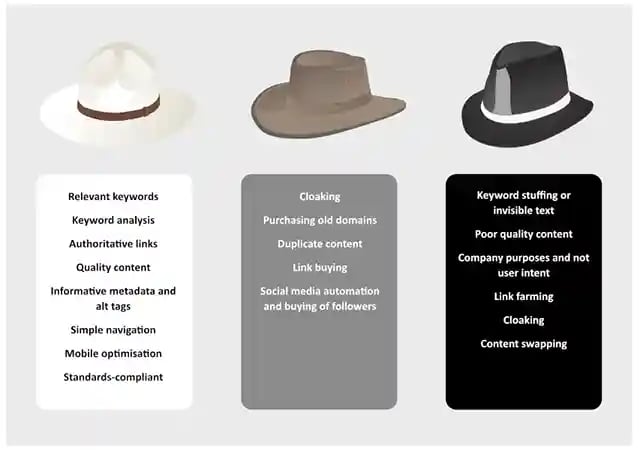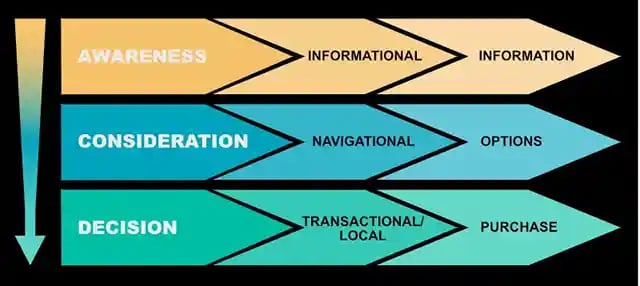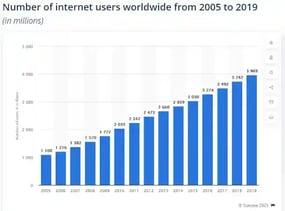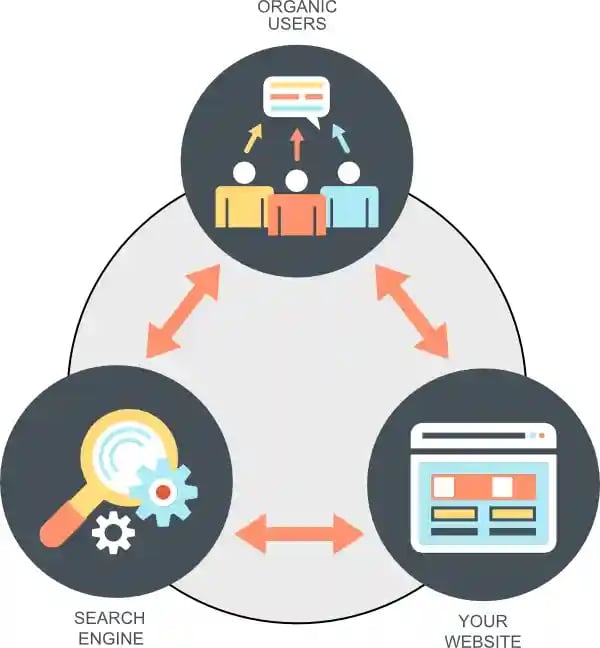Chapter 1
An SEO audit, what's all the fuss about?
Is an SEO audit a fuss about nothing, or something really important? All is revealed in our infographic.
Do you want to improve your site traffic, boost rankings and overall user experience? Of course you do, hey we all do right!
One sure way to make this happen is to undertake an SEO Audit. But what is an audit all about?
An SEO audit, what's all the fuss about?
What is SEO?
What are the most important parts of SEO?
Types of SEO
Action your findings
Chapter 1
Is an SEO audit a fuss about nothing, or something really important? All is revealed in our infographic.

An SEO audit isn't as daunting as it first seems.
We will talk through the basics plus much, much more. (HINT: there’s also an SEO Audit: Essential Extras reference guide)
With our SEO Services first-hand experience, we’ll show you all the ways to prepare for and undergo an audit.
Pure optimisation but without the fear, jargon and headache associated with it.
Before we jump straight in, you can download this article to have on the go and refer to it whenever you need it.
Ready?
Let’s go!
We always hear how vital Search Engine Optimisation (SEO) is, but what is the real fuss about?
Why should you be concerned about having an SEO audit, is it that important?
In short, yes!
SEO and conducting an SEO audit it is extremely important.
To keep it simple, let’s relate it to something we all know and understand. Our bodies!
To make sure everything is in working order we would visit a doctor.

They run tests, retrieve information and analyse the data presented. This information shows you what is working well; what isn’t and the areas in which you need to take care of or improve on.
Having an SEO audit is the digital equal of you going to the doctor for a check-up.
I know you might be thinking that’s all well and good but I’m fit and healthy and don’t need a check-up.
That’s amazing, we want you to be in the best possible health. Though guaranteed, if you haven’t undertaken an SEO audit, your website needs this digital check-up.
An SEO audit is the process of analysing and improving your web presence organically. Relating to best practices it identifies and highlights areas of strength and weakness. These results aid improvement to succeed with measurable and tangible outcomes.
On the surface, biologically and digitally everything can appear to be fine.
Like the intricacies of our biological makeup, our website has digital complexities that need expert knowledge too. Undertaking an SEO audit not only highlights negative areas but also many positives.
Everything looks better in the dark for the fact that you can’t see it completely. Don’t wait for the light to come on and expose any flaws, pain points or blockages. Act now and let an SEO audit be your digital Dr.
Read on to learn about the beauty and excitement of an SEO audit.
Yes, I said excitement and SEO in the same sentence! As we delve deep, you will become a total SEO audit fan.
Find out how to equip your business, team and website with the extra arsenal for all it needs.
An SEO audit is amazing and highly recommended, but there are some limitations!
As we’ve established, an SEO audit is an essential health check for your SEO website audit.
We have put together the ultimate SEO audit checklist. Its purpose is to locate and identify issues that are affecting your organic site performance page by page. This procedure should occur regularly to achieve optimal results.
Unlike a traditional technical SEO audit which solely covers technical performance. A comprehensive SEO audit covers both structural and content components to give you a broader picture of your current SEO state.
Plus, it explores keyword research, competitor analysis, and more to improve your SEO visibility.
To be beneficial, an SEO audit can’t be rushed. With all its components, it’s like a masterpiece, taking between 2-6 weeks to complete.
This of course is dependent on the size and age of your site, also factoring in time elapsed between previous check-ups or changes made to your site.
Time is needed for an SEO specialist to conduct a thorough investigation to produce accurate results and actionable SEO audit recommendations. Once complete, you’ve armed with all the knowledge and information to action the changes needed for every single page of your site.
On your initial audit, you don’t have to action all the changes at once of course. You can put an SEO strategy in place to gradually accomplish the small wins which you will be able to actively measure. Targets met will unfold into big wins, allowing your site to shine through the digital crowd.

Apart from a few things like flying to the moon or conducting brain surgery, most things can be approached using a DIY mentality. We totally get that!
You’re more than capable of pottering in the garden or painting a room. However, if you’re trying to landscape your whole garden or paint the whole house. It would be advisable to get the professionals in at least or some help.
This is effectively the same for an SEO audit of your whole site.
It is a grand task to undertake and sometimes you need the professionals to come in and do it for you. Or at least some assistance to steer you in the right direction. (This is where we can offer our expertise)
Conducting an SEO audit is the process of making your site easier for search engines to understand and improve your overall user experience.
The ultimate goal is to increase your organic traffic through search engines. This is done by improving your rankings and the position you appear in the Search Engine Results Pages (SERPS) for various search criteria.
SEO was simple, to begin with, but over the years has vastly increased in its complexities.
When optimising a website for search engines there are many rules and regulations to keep in line with search engine ranking factors. All the while, still keeping your users happy.
We are within the age of information and as technology has improved SEO has diversified.
It is now split into categories that carry its own rules. The SEO audit process remains the same, yet the division is designed to make each SEO category easier to manage.
In later chapters, we will detail what each category consists of. Yet this list presents the enormity of information considered and undertaken when completing an audit.
If you’re a company with a constricted budget then a bit of DIY may be the better option.
Whereas if you’re a company with a larger and more flexible budget, you will benefit from hiring an SEO expert.
You may even consider hiring an SEO team, or at minimum, spending on training someone in-house. But that can take up valuable time and resources.
Good SEO is not cheap and cheap SEO is not good
SEO takes a lot of work. If done correctly you see major benefits, yielding great results as you stay on track and up to date. If done poorly…..I’m sure I don’t need to elaborate.
Succeeding in business is a personal journey and there are many factors that affect it. To complete your own SEO audit is perfectly possible.
But when deciding between DIY or an expert, you really should consider:
There are free tools and platforms to conduct your audit, though with limited capabilities. Your time and knowledge may cost you, as your attention is diverted from other areas of your business. Compiling, presenting and making sense of vast amounts of data may also be overwhelming for both you and your team.
When completing a comprehensive SEO audit, we draw initial information data from a minimum of 6 sources including:
You can see that’s an incredible amount of information to analyse. Excel is just not able to handle this level of data. So what do we do?
Use an Application Programming Interface (API) to squish all the data into a fantastic platform BigQuery! What’s that I hear you ask, I will let Google explain.
BigQuery is a cloud-based data warehouse for storing and processing large datasets
Like Ronseal, BigQuery does exactly what it says on the tin!
Not only that, all your data can be analysed, processed and formatted at lightning speed. BigQuery handles limitless data, ouch for Excel!
To top it off we sync it with the visualisation tool of your choice. And produce custom reports from your combined data drawn from the numerous platforms.
Magic, but what does it tell you?
Read on to find out.
You know how and where the SEO audit information comes from and that it can create custom reports. But that’s no good if you don’t know how to use it. Let’s see what magic it can bring.
BigQuery allows you to process data, plus apply Structured Query Language (SQL) logic. This is where it gets really exciting. Put together it allows for fabulous automation to produce usable information such as:
Organised, and formatted, this data is ready to view and for you to rock and roll. Each and every page of your site has been analysed for you to make an informed SEO decision.
That’s an instant saving of physical spreadsheet work, or creating formulas or using VLOOKUPS or pivot tables. But wait, it does even more.
Pages are read and determined by category e.g. blog post, product page or landing page etc. This allows you to highlight and analyse specific sections of your website and optimise your data by comparing like for like performance.
At a click of a button, you can pull up and group each blog page performance, rather than having to sift through or have it compared to a product or landing page. Breaking up your analysis by page category saves time and is very helpful for companies who have large amounts of data to sift through.
Still unsure if this SEO audit process is for you? The next element will make it your all-time favourite.
I know, read that heading again. Can you imagine, we used to have to do this manually with each and every URL.
Now, BigQuery absorbs the information, churns it up and spits it out with specific actions and direction to improve Site SEO on each and every page.
This is mind-blowing, not only because it's genius but it provides the perfect blueprint for any SEO campaign. You know exactly where and how you’re going to optimise your ENTIRE site.
These actions are broken down into 4 categories for analysis:
Within your report, you can view what actions have been taken and the remaining opportunities to render.
As stated it is the optimal practice to complete an SEO audit regularly. With using BigQuery for your SEO audit, you have the power to schedule or refresh at regular intervals or whenever is convenient.
Depending on your site size, structure or current project. Your refresh schedule could be daily, weekly, monthly or yearly! Though we usually opt for clients to have a manageable monthly schedule.
That is enough time for improvements to show progress and for any new issues to crop up and be nipped in the bud.
This is a simple and cost-effective way to monitor SEO changes, progression and trends over your campaign.
You now know that an SEO audit is a necessity rather than a choice.
But are you up to date with what SEO actually is and what types there are?
Delve into the following chapters to brush up on your knowledge and get all the know-how.

Have it your way!
Download this article and access it whenever and however you want to.
Chapter 2
We want to put the record straight, bust any myths and calm any fears you may have. When implemented correctly, SEO is your ultimate website cheerleader and friend.

| JUMP TO SECTION | |
| What is SEO? | SEO best practices (do's and don'ts) |
| SEO: a powerful phrase | Why do we need SEO? |
| The basics of SEO | Tools for SEO (free &paid) |
So we’ve been banging on about undergoing an SEO audit.
Offloading information of the do’s, don’ts and what the best practices are.
But we haven’t actually stopped to explain SEO in detail.
Don’t you just hate it when enthusiasts continually bleat about their topic of passion and don’t stop to explain!
Sincere apologies, we’re just SEO nerds around here who are fascinated by the world of Search Engine Optimisation. We get overly excited and can forget ourselves sometimes!
SEO. A powerful three-letter acronym that has the ability to evoke:
All of these emotions from one tiny acronym! Depending on whom you talk to, SEO is either marvellous, misunderstood or misrepresented.
So we want to put the record straight, bust any myths and calm any fears you may have. When implemented correctly, SEO is your ultimate website cheerleader and friend.
In its basic form, SEO is the process of optimising your website’s visibility and increasing organic traffic from search results in Google, Bing, and Yahoo etc.
As you explore this chapter, you will begin to see why SEO is so powerful. Why it’s so important and how it delivers on all of the emotions stated.
SEO encompasses all of these elements
To get these elements in tip-top condition, with optimal performance. You will initially concentrate your SEO efforts on these 3 categories:

This investigates the technical parameters that affect your visibility to search engines. Then addresses any issues that search engine spiders have in crawling your website and indexing it.
This is to make sure each page of your site (and its content and images) is friendly for search engines and users. Ranking is performed on a page-level basis and accumulated as a whole. This is why it’s extremely important to optimise each and every page of your website. Your overall ranking may be lower simply due to unoptimised pages.
This is all about the promotion and leverage of your website. The more popular you are the higher you may rank in search engines. This can be achieved through link building, social media platforms and brand promotion.
As you can gather, we’re just setting the basics here. There are a ton of other aspects of SEO that we will delve into later. But for now, just know that these are the three main (maybe even most important!) categories of SEO you will use.
Now as if SEO did not seem complicated enough, we have different types of hats that are used and penalties that can be dished out for using the wrong one!
Yes, search engines are quite strict in the way websites they index conduct their SEO business. And if you don’t observe the rules you will be penalised. This affects your rankings and trust.
But don’t fear. The best thing to do is know what NOT to do, so you’re confident with the right way to approach SEO.
You may have heard of three types of SEO practices:
White Hat SEO- uses ethical tactics and follow search engine guidelines
Grey Hat SEO- uses undetermined tactics that neither fall under white or black hat.
Black Hat SEO – uses risky practices against search engine guidelines.
All of these practices are used but not all of them are beneficial to your site's progress. All three also carry their own level of risk.
White Hat SEO follows the rules but has no certainty of working, Black hat SEO definitely works (until it doesn’t) but almost always is unearthed by search engines and punished. Then there is Grey Hat SEO, literally a grey area, with practices undetermined until search engines deem them white or black hat tactics.
This is why you need to know what each practice entails so that you can avoid using SEO that incurs penalties or total wipe-out. Concentrate on using SEO that helps you provide quality content, good user experience and well-earned positions in SERPs.

You don’t want to get on the bad side of a search engine. So if you’re unsure that a given method is going to violate their regulations or guidelines, it’s probably best avoided. Algorithms are gaining intelligence and becoming more sophisticated at a rapid rate. So your safest route is to always use, or seek an agency that performs White Hat SEO.
You know SEO can help boost your online traffic and credibility.
Further to that, it also improves the overall user experience and engagement that your target audience has with your brand.
At the beginning of this chapter, we associated some emotions with SEO.
These are closely linked to the emotions that your user personas experience within their search journey, as they travel through their buyer’s journey.
Confusing, I know, so let’s break it down.
Buyers Journey
The process your buyer persona goes through to become aware of, consider evaluate, and decide to purchase a new product or service from you.
Search Journey
The search journey looks at context and uses that information to provide the content that is relevant to where they are in their buyer’s journey rather than churning out any answer to a query.
What this means for you, is that search engines intelligently use your user’s history to figure out what stage they are in their journey. Then deliver relevant content that’s fit for the purpose of their buyer’s journey stage.
This is why SEO is so important to use on your site, both for search engines and customers! To appear as relevant content in SERPs, you need SEO to ensure your content is optimised and understands and answers the three main points.
Google, in particular, list some of the key factors that determine results returned from a user’s query:
This is all well and good to know. But how do those three questions transpire into writing and optimising fitting content? Below are examples of ways in which people may use search engines for each stage.
Informational: want to seek information for knowledge of a topic (who is…?, How to…?)
Navigational: trying to find a specific place, source or site (FB, YouTube)
Transactional: want to purchase something (cheap digital cameras, 4* hotels in Central London)
Local: looking for something in their local area (Thai restaurants nearby, 24-hour gyms in my area)
Now you know the language that is used within their search journey, it can be better married to their buyer’s journey.

Now you have more confidence and optimism as to what SEO is. You know what you want, what to look for and where you want to go. You just need help in identifying the gaps and pointing you in the right direction.
Like most things in life, there are free versions and paid versions of SEO tools. That by no means determines the quality or effectiveness of each tool. Free versus paid simply affects/limits the type of data you receive.
Paid tools pack a bit more of a punch (let’s face it you are paying for it!), and show you the exact information you want to extract. Free tools are great if you’re just starting, or a small business and want to get your head around SEO data and analysis before using an SEO expert or purchasing the big ones.
Free SEO tools
(some of these tools also provide paid versions)
Paid SEO tools
SEO is an extremely powerful digital marketing tool and fits any type of website.
An SEO-optimised website is a happy one.
It will try to show itself as best it can to the outside world through high visibility and improving user experience. Make your site happy and give it some TLC by way of SEO.
Chapter 3
To execute as an effective marketing strategy, SEO has many important elements that need to work together in order to be successful.

| JUMP TO SECTION | |
| What are the most important parts of SEO? | Algorithms and Ranking factors |
| Important elements of SEO (overview) | |
What are the most important parts of SEO? We would say all of it!!
But SEO has many elements and it can be complex in its use and implementation.
To execute as an effective marketing strategy, SEO has many important elements that need to work together in order to be successful.
SEO is a brilliant marketing tool. You just have to fit it all together.
So think of it like this.
Each element is like the paving stones in a digital path to your website.
If one is wobbly or deteriorated, the path becomes unstable or eventually an ineffective route to take.
So, not caring for (optimising) this path equates: lower visibility, less traffic, lower rankings and ultimately fewer sales.
Completing an SEO audit is a way to ensure all elements are in working order, providing optimal performance. An audit pushes SEO to work for you, improving: authority, traffic, conversions and more sales.
Want to unravel the secrets of the elements?
Let take a look!
There is a lot of information to absorb when it comes to SEO.
If you want to digest it in small chunks at a time, just click on the relevant element. To return here, click 'back to menu' placed at end of each section.
For search engines to rank your site correctly, its overall structure is extremely important.
We’ve all had that moment where we’ve clicked so many times to try and get to where or what we want. But to no avail!
We either get frustrated and give up or get lost within the sites pages, landing on something we didn’t want.
As your first point of call, looking at your sites current structure is helpful in beginning your SEO process.
An audit will look at
If you don’t like spiders look away now!
Actually don’t, you need these creepy web crawlers we are talking about the googlebot.
Crawling and indexing are two spate processes. But go hand in hand under the consideration of searching, organising and storing your site's information within search engines.
Crawling
Search engine spiders (aka web crawlers) are used to crawl your site to discover its, relevance, content quality and intent.
To simplify a complicated process. Search engine spiders scan the Internet to find web servers hosting websites.
They visit each site to discover:
With the information obtained, it gives them insight as to where to place you in the SERPs.
There are over 4.2 billion pages on the Internet, spread over 8.2 million servers
That’s a huge amount of information to digest. And that’s not including that they view variations of word meanings, plurals, and multilingual sites. Plus extract meaning from voice search to match the written content.
WOW!
This is why your site needs to be crawl-ready, to make the spider’s job easier. They will reward you for it in the end.
Your site structure, including internal links, XML map and robots.txt is important.
Robots.txt is a file that instructs search engines on how to access your site. You can control what is or isn’t accessible to them.
Robots.txt can be tricky, if not formatted correctly the WHOLE of your site may be on show or may be completely blocked. (Unfortunately, this does happen)
Once identified this is easily fixable and you will see an improvement.
Indexing
Crawling is not enough to supply a search engine.
Indexing is where the information from the spiders is collated, organised and stored.
Once the information is presentable, it’s then passed through the algorithms and processed before reaching the user in SERPs.
Obviously, the search engines don’t store EVERYTHING from a page in their index. But are mindful of important factors for algorithms such as:
This is an idea of what is highlighted, for there are many more parameters set, depending on the algorithms used at the time.
Crawling and indexing are extremely important.
Search engines are pretty much a huge library. If your site is not readable, it can’t be indexed. With no indexing, your site can’t be displayed in SERPs as the best book to read.
Completing an SEO audit allows for these otherwise unknown errors to come to light and be improved.
Now you have looked over your site structure and navigation.
Addressed the crawling and indexing process.
Now you get to concentrate on the important bit.
They’re what it’s all about.
Without them, you cease to exist.
So naturally, you want to make sure you’re doing your best for them.
To do this well you have to watch (sometimes learn from) and know who your competitors are.
Ask yourself:
There’s nothing wrong with a bit of healthy competition, it keeps you on your toes.
If they’re doing something you think your audience would benefit from, you can adapt it to your fit your brand.
We’re not suggesting plagiarism but there’s also no sense in reinventing the wheel!
It’s always good to have a role model to look up to in life, and the same applies to business.
This is where you need to step into your personas' shoes.
You need to feel what they do, get inside their head to know what information, product or services they may be seeking.
This may seem impossible but it can be done.
User intent can also be known as query intent or search intent.
Regardless of what you call it, you’ll want to know:
Taking time to understand these questions gives you greater insight into your customer's needs, wants and preferences.
Showing you how you need to present to your audience, taking into consideration all of these SEO elements.
We touched on this in the ‘Why do we need SEO?’ Section. Explaining how your user's search journey ties in with their buyer’s journey.
An in-depth seo audit is a great way to reveal patterns and keywords.
These can be used to create great content, better engagement, higher conversion and overall, an improved user experience.
Keyword research is uncovering the terms, phrases and keywords that your target audience uses when conducting search queries.
Observing your industry, audience and user intent gives you a broader perspective when it comes to keyword research.
You’re armed with greater depth details, to aid in pinpointing keywords you want to rank for or include in your SEO strategy.
With your documented research, you’ll be better able to adjust your SEO strategy with the subtle shifts & turns of worldly events, industry trends or persona alterations.
To link, or not to link, that is the question….
Links are a tricky business.
They’re an integral part of SEO and can affect many factors of your site's success.
But there are a few things you need to consider when choosing links
Regardless of what link it is (internal/external), quality is the first thing you need to be concerned about.
Search engines like to create trust with users and don’t appreciate links that will harm that relationship.
You don’t have to have external links but this can help with authority and trustworthiness if you do. It also means you give due credit to other quality websites like yours, helping them in their journey.
Internal links are a must! The point is, that you want people to know about you and search for your site, products and services. So give them something to click on!
You can overdo it with links but there’s a handy little option of no follow if you don’t want to run the risk of being penalised.
An SEO audit looks for the potential issues with your site's links covering:
Used effectively, links are a great way to improve ranking, authority and traffic.
Numbers tell great stories.
But only if the correct ones are reported AND you know what they mean.
There’s no point putting in all this hard work and then being unable to pinpoint or measure where your successes are! If you can’t measure it, it can’t be improved upon.
That’s why you need accurate SEO analytics and reporting.
The reporting acts as your road map, highlighting all the bumps in the road. With the analytics being like the navigator to your website in the digital rally.
Reading the stats help you steer from pitfalls and mishaps, whilst showing the competitions’ route and how you can compare and learn.
When approaching or amending your goals always ensure they are SMART:

Reporting and analytics help you track progress, understand your SEO ROI and provide insights to optimise your SEO campaigns.
Ever wondered why a change or update in search engine algorithms matters to business so much?
Algorithms are what search engines use to provide the best possible search results.
That is fantastic, for as a user that’s what we want.
On the surface, algorithms don’t affect users directly.
To a business, however, a change, update or even minor tweak can send us running for the hills.
Google is one of the leading search engines and is known for providing the best information fast.
A lot of time is spent researching how consumers search for and access information, facts, products and services.
Google’s goal is to display the best and most relevant results possible to your query, whilst providing the best user experience.
To do this they create algorithms that serve the people.
Five recent major algorithm changes are:
Neil Patel discusses these algorithm changes in greater detail here
Google are CONSTANTLY updating and tweaking in the background before and after major changes are released.
But it’s for good reason.
What we need to understand is that people and technology change, so algorithms have to change too.

The evolution of SEO! 20 years ago we didn’t have the plethora of social media platforms we have now to funnel traffic to our sites.
Nor did we predict that our sites would have to be mobile-friendly. Due to over half the population preferring to open emails on the go and view sites via their smartphone.
Plus, 20 years ago we had far fewer internet users to consider and align with.

According to Internet World Stats 2001 saw 5.1 million internet users. Compared to 2020, a staggering 5.5 billion users currently use the internet.
Algorithms are needed to accommodate change, flexibility and fairness.
Via a combination of algorithms and ranking factors, web pages are ranked by relevance in SERPs
It’s this combination that puts fear into businesses.
What are ranking factors?
These are driving factors that algorithms use to determine the best possible results. Google use over 200 ranking factors within their algorithms. Which include domain, page, site, backlink and user interaction factors, to mention a few.
The most important Google ranking factors of 2021
For an in-depth look, Ryan Dean at Backlinko generously compiled a full list of ranking factors.
It’s packed full of information examples, tips and tricks.
Check it out to keep up to date.

In essence, we all serve each other:
Without organic users, there would be nobody visiting search engines to find our sites.
Without our sites, there would be no need for search engines to direct organic users.
Without search engines, there would be no way to direct users to our sites organically.
Therefore there’s no need to be frightened.
Although algorithms have rules and regulations, search engines are quite upfront in how to help sites rank.
This helps avoid sticky situations and receiving penalties.
Though nobody can predict what algorithms will be used (designed to keep us on our toes!), many factors are usually within our control.
Being on top of your SEO efforts and completing regular SEO audits help to maintain the upkeep for any unexpected algorithm releases.
Chapter 4
With the fast growth of SEO, tackling it as a whole has become rapidly confusing. To make it easier SEO has been split into manageable sections, or ‘types of SEO’.

With the fast growth of SEO, tackling it as a whole has become rapidly confusing.
To be perfectly honest, it can be overwhelming at times.
To make it easier SEO has been split into manageable sections, or ‘types of SEO’.
As mentioned in the ‘What’s SEO?’ section, there are 3 main types of SEO.
Technical, On-page and Off-page are broadly spoken about, yet there are few other sub-divisions of SEO.
The divisions are not to dilute the importance of any type of SEO. But simply to make it easier for concentrating and adhering to the specific rules, regulations and parameters for SEO.
As we continue to wade through the explanations of types of SEO, jump to any relevant section (or one that takes your fancy) by clicking the links.
To return hit back to menu.
Your content needs to:
On-page SEO actions take extra care when looking at and optimising:
How do you do this?
ALL SEO is beneficial for local SEO. But local SEO is specifically the process of optimising your website so that it appears highly in SERPs for your area, city or country.
In order for local SEO to be effective, you need to sign up to Google and take ownership of your Google My Business (GMB) listing.
Some of you may already be listed on GMB but you don’t appear at the top in a local search.
Why not?
Local SEO of course! You need to make sure your listing is optimised to its fullest capacity to get that top ranking.
The secret?
Actions to get ahead for local SEO:
Though these are some of the things to consider, Google also uses some of the following as ranking factors to aid in ranking highly in local searches.
Whether you’re an online & local business, online-only business, or local-only business. Local SEO can work wonders for your direct traffic, visibility, local rankings and long-tail keyword ranking.
You have the best product or service around.
But you’re not reaching your audience or selling as much as you want to.
Why?
One sure reason could be that you’re just not out there or being specific enough.
That may sound insulting but I can assure you no harm is meant.
It's obvious to state that the goal of E-commerce SEO is to make your online store highly visible in SERPs when customers search for the product or service you sell.
Yet, to achieve this high visibility and ranking you have to knuckle down to the nitty-gritty and be specific.
For e-commerce, being specific means knowing your important pages within categories/products and assigning keywords to each page.
Yes, I said each page.
You may have a billion pages, but start with your most important pages first and then work outwards.
You also have to realise that trying to rank for general terms, is not going to get you ranking.
For example, let’s say you’re an online clothing store selling women’s clothing

Unfortunately, you’re never going to outrank these top dogs.
But there is another way…..
An SEO audit can give you the help needed to identify your main keywords and determine long-tail variations that you can rank for.
Want to know another valuable trick?
Similar to competitor analysis, an SEO site audit tool used within the SEO audit will show who is using your keywords and long-tail variations, and what pages are ranking for the exact kind.
An SEO audit concentrates on uncovering opportunities for optimisation of:
Plus addressing technical issues, site structure, and internal linking.
eCommerce SEO helps your brand to be specific and attract qualified leads for higher conversion.
Of course, there are paid searches. But long-term an SEO audit costs less and gives a greater ROI.
In 2020, the number of unique mobile internet users stood at 4.28 billion, indicating that over 90% of the global internet population use a mobile device to go online.
26/03/2021 statista.com
Don’t know about you, but we had to read that a few times!
When you think about it and break it down, it’s actually true.
Gone are the days where mobile devices (phone and tablets) are clunky or slow.
Now, they’re an everyday commodity for millions of us. Going wherever we go (including the bathroom!)
So, as digital markets develop and mobile technologies become extremely sophisticated and more affordable. We need to be aware of mobile SEO and ready for mobile search and being mobile & device friendly.
The figures are vast now and are only set to increase. So strap up and let’s get to it!
With such high demand from mobile users, Google created the mobile-first index. They use the mobile version of a website for ranking purposes.
What does this mean?
If you’re not already optimised for mobile, you will slowly wind down the slippery slope of rankings. This equates to major traffic loss, and we don’t want that.
What do you do?
Do an SEO audit (you knew I was going to say that). The audit will uncover if your site is optimised and mobile-friendly.
If you already are mobile-friendly or currently have a responsive website, high five to you. You’re heading in the right direction, but that alone is not enough.
Mobile SEO is the process to ensure the ultimate experience for users, tailored to their device.
They want it visually pleasing (think of device orientation), be actively engaged (can all content be seen or accessed) and most importantly FAST (the 3-second rule and we’re not talking food!).
Mobile SEO actions include:
There are also Accelerated Mobile Pages (AMP). This is a mobile-friendly structure with faster loading pages compared to traditional pages. AMP HTML (a reduced version of HTML) gives better browser pages for mobile.
We are an impatient breed and want everything yesterday. Mobile SEO is necessary as a damage limitation strategy, as mobile usage is set to soar.
If your site doesn’t keep up with the times and optimise accordingly. You will feel the wrath of search engines.
This will be felt via a decrease in rankings, traffic, prospects, conversions and ultimately revenue.
So there you have it! Information overload for sure.
We only have one more chapter to go!
Please remember you can download this WHOLE article for your convenience and reference, and also the SEO Audit: Essential Extras reference guide too.
But hopefully, now you have a clearer understanding of what types of SEO there are and how an SEO audit can benefit you with each of these.
Obviously, we’re SEO fanatics and love everything about SEO audits (I know sad). But one thing is for sure, even if you don’t totally understand it, your site, team and customers will appreciate it.
No, the gratification is not instant, Rome wasn’t built in a day and all that! But over time, strong and steady results emerge.
No matter when or how you start (though we advise NOW!) Once you have strong foundations, the only way is up.
Chapter 5
When your SEO audit is complete, the most important part is to action your findings.

What’s worse, than when somebody’s unaware that they are doing wrong?
When they do wrong, know it’s wrong and do NOTHING to fix it!
When your SEO audit is complete, the most important part is to action your findings.
This may seem like an obvious thing to do but we have seen clients get overzealous during the actual process of the findings. Then when all is revealed, they address a portion of it or sometimes none at all.
When this happens, it literally breaks our little hearts.
One, because we LOVE this stuff.
Two, we know how beneficial our findings are
Three, we can literally see how you can improve and grow
Four, you have wasted your money and won’t see your true ROI.
You have to prepare the ground, then nurture it to fruition. The same goes for your site.
We will help to make sure your site is set up for fertile ground, but you have to give it the due attention needed to grow and multiply.
Our motto at Whitehat is when one succeeds, we all succeed. We enjoy nothing better than getting you the results you deserve and hearing the unfolding success stories of growth.
So we have incorporated a few sections on how to action your findings after your SEO audit. Because as you have seen the information can be quite intense, but never fear Whitehat are here!
As we saw from the ‘how is my SEO information displayed?’ section that the data can be overwhelming.
The trick is, target your specific areas of need. Tackling the one that’s most in need.
Areas of error may include:
There’s no set way to action your findings. But it’s best to set some solid goals and expectations so as to not wander aimlessly in the SEO Sea.
Logically it’s best to start with any architectural or security issues.
If you start with content and produce amazing works, it will be pointless if your navigation, robot.txt or security is out of sync.
Sort the red flags first and then begin to tackle ‘low hanging fruit’ pages. Complete the easiest achievable task first. Refine the assets you already have to uphold whilst you repair or prepare the rest.
Pages that are ranking reasonably well for your keywords can be tweaked (think titles, meta data, anchor text, main body text). These small improvements will produce quick wins of better rankings, bounce rate and relevance.
Prioritise – not all corrections carry the same amount of impact. You need to know in what order they should be actioned. Once an audit is completed an executive summary is given with guidance on this.
Timeline – SEO is a long-term commitment stimulated by short-term activates. Due to the high level of execution and expectations. In order for you to see a genuine ROI, SEO actions need to be planned and resourced effectively.
A timeline gives the scope to implement specific goals, milestones and reporting. Making sure all evidence is recorded to measure the impact against the input of time and effort.
Action plan – with everything else in place your action plan simply needs to depict
Though simple in set up, do not disregard this step.
Be sure to use a tool or programme to guarantee success. You don’t want to do all this work to find an action plan stuck in a draw or folded to prop up a wonky desk.
Actioning your SEO audit findings is a big project.
It should carry the same project weight as the audit itself.
If nothing is actioned the entirety of the project fails.
They say success is a journey, not a destination, but you have to get off the train at some point!
How do you know you’ve arrived?
By setting your initial goals and expectations from the outset.
Then when you reach this point of ensuring conversion, you’re able to marry the two and see where you have succeeded. Having clear measurable outcomes with data and indicators to boot.
By setting goals, targeting specific areas, having a set timeline and plan of action. You can understand and measure actual impact versus estimated levels.
An SEO audit is a powerful optimisation tool for your website. We know it can be overwhelming and that’s why we’re here to give support and advice throughout but particularly at the end.
If there’s anything that’s not clear or you would like to know more about, please get in contact.
Remember SEO is what we do and we love talking about it, but even we found it hard in the beginning.
So helping people like yourself find their own SEO way is the best, don’t be a stranger, and please download your SEO Audit: Essential Extras.

Download today to be ultimately prepared and one step ahead in the SEO game